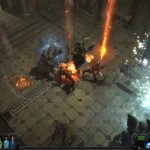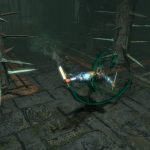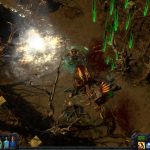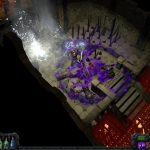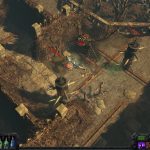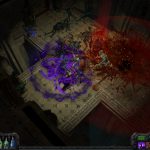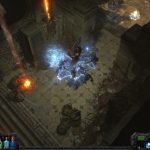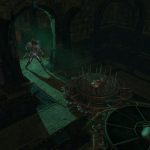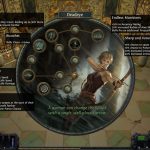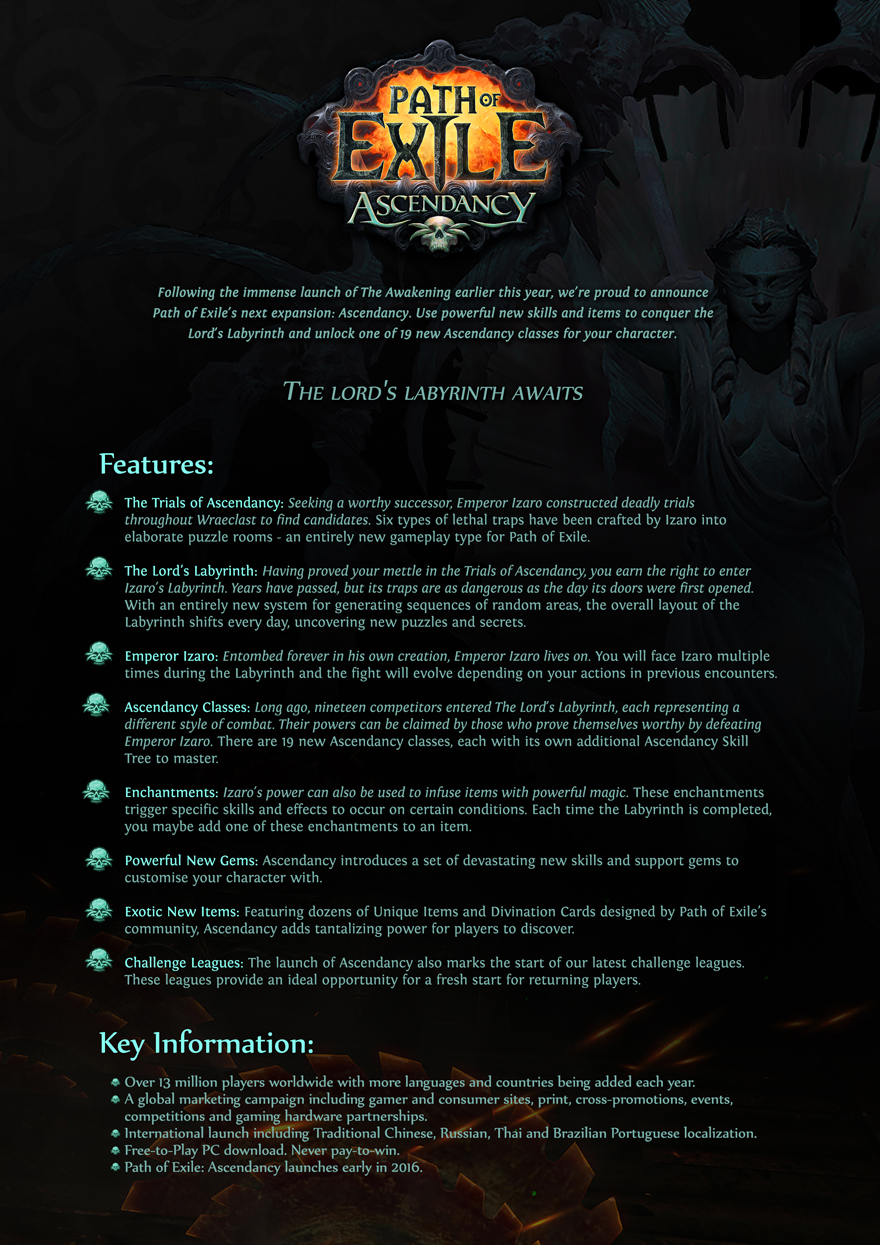
Dubbed Ascendancy, this expansion focuses on an ever-changing labyrinth that players can delve into, full of puzzles, traps, and sometimes even secret rooms. There are three new skill specializations for each class, and a new type of enchantment to add to gear. Unlike The Awakening, Ascension is not a continuation of story and content at the end of the game; it isn’t Act V (which will be coming later). Instead, it is designed for everyone to participate in. Here’s the scoop.
Trial by fire… and spike… and saw blade….
The crux of Ascendancy is the labyrinth. However, players can’t just waltz up and enter it — first, they have to prove their worth to do so. The story behind the labyrinth is this: The Lord’s Labyrinth was built by Emperor Izaro a couple of hundred years ago as a way to find a successor to his throne. To be worthy to enter that challenge, one had to first pass through a series of trials throughout the world. Completing each of those six trials successfully then granted access to the labyrinth.
What are the trials? Each one is a mini maze that introduces a type of trap to the players. In one, players will face spinning blades. In another, there will be spinning saw blades. There are six in total. Each time players will have to figure out how to counter the trap in order to make it through to the end. The trials, Wilson noted, have a two fold purpose: Besides testing players and making them earn access to the labyrinth, they teach players about the various traps they will find once inside. This becomes handy because, as Wilson explained, “Later on when they encounter [the traps] in the labyrinth they’ll be getting them in combination with other traps, and it helps them to know exactly how the mechanics work beforehand.” By the time a player completes a trial, s/he’ll understand exactly how that trap works.
 Into the Labyrinth
Into the Labyrinth
The culmination of the trials is the labyrinth itself. As you might expect, the labyrinth is a maze filled with monsters. You’ve also already been warned that there are traps. Basically, it’s a huge map filled with indoor and outdoor areas, corridors, and even secret rooms, all promising reward for the successful adventurer. That all sounds pretty standard for a labyrinth, so what makes this one special enough to be a major expansion?
For one thing, there are mutually exclusive choices that affect game-play. Players will be faced with decisions that will literally determine their paths and direct what will be available during the run, choices such as do you go right or left, or do you open the first door or the second? Some of those choices might not be as exclusive as they appear, however; Wilson described how even when players choose one path/door/room over another, a hidden corridor could potentially connect them, allowing players to enjoy the rewards of both… if players actually discover said secret passageway, that is.
Choices also affect the ease or difficulty of the experience in various ways. During the three boss fights, what players do during one fight will literally impact the next. In addition, while taking a secret passage might help players to bypass certain things, the question is if they want to. Bypassing a boss fight could grant the next version of the boss you encounter significant power and advantages. There are also dark shrines that will grant players positive bonuses or negative curses, or potentially even both. Do you click it and take the chance, or leave it be? You might be made weaker, but you might also get better loot throughout the run. Decisions, decisions.
But that’s not even the best part. Here’s where it really gets good. Even with traps, puzzles, secret passage ways, and gameplay-affecting choices, you know players would grow bored. After you’ve memorized the layout, taken every path, and experienced every choice, what would keep this instance from becoming stale quickly? How about if you couldn’t actually do those things? How about a new, randomly generated map every day? We’re not talking about cycling through a rotation of set maps that players can memorize, either. We are talking about each aspect of the labyrinth being a separate building block generated separately, from the hallways and rooms to the traps to the doors to the alters. All of it. Even the boss fights are randomly generated. What is in the maze as well as where it is changes each and every day. And these blocks aren’t just haphazardly dumped in a jumble; the program generating the maps does so in an intelligent way so that the finished product makes sense. For instance, if the labyrinth has gold doors inside, the program knows that a gold key must be also generated and placed somewhere.
Add daily random regeneration to game-altering choices and you’re talking serious replayability. “Our goal here is that for many months the players see a completely new labyrinth every day,” Wilson explained. “So ideally they are encountering new mechanics they haven’t seen before.” That can even happen before the map changes over for the day; players can go back in and replay the zone as many times as they want, making different choices as they go. (If you think you are missing something or you want to have a more informed run, you can check with the community for hints and tips about that day’s map.)
The cherry on top
Just when you thought the deal couldn’t get any sweeter, it does. The Lord’s Labyrinth, with all of its cool game-play, is not restricted to characters who’ve finished the story. Unlike Act IV, where the story and bulk of the content were for players at the highest difficulty levels, Ascendancy incorporates game-play throughout the game so all players can participate. “We put these [trials] throughout the game, including the first difficulty levels,” Wilson explained. “People will start to encounter them as early as 30 minutes into the game when they enter the prison area. Our goal was to make sure people saw the game-play early and have a chance to experience it regardless of how far through the game they are.” Wilson explained that the labyrinth itself takes place about two-thirds of the way through the regular game play.
To keep the labyrinth viable for the range of player skills there are three versions, starting with Normal and ending with Merciless. The labyrinth also scales for group size, so the challenges will be harder for a group of six than for a solo adventurer. Note: Once the maze is started with a certain challenge level, it can’t be changed. That means if group members drop out, it will remain the difficulty level of the initial party. So for folks who really want the ultimate challenge, choose Merciless, go in with a full group of six, then have the other five drop out! It is also important to note that once you have crossed the threshold into the labyrinth you are locked into it until you finish. Wilson noted that a general player will take on average 45 min to an hour to complete the maze; there will be a leader board each day to show the top ranks for completion time and difficulty.
 The pot of gold
The pot of gold
Besides the lure of seeing the ever-changing layouts, why would someone want to run the labyrinth multiple times? For the rewards, of course! Wilson revealed that the labyrinth has two main rewards: one large one for the first run and a smaller one for every completed run. The big reward is a new ascendancy class. This specialization gives players another way to further personalize their characters skills with a specific role. For anyone intimidated by the massive skill web, take heart: This specialization is less complicated and has only a handful of skills to choose from. The harder choice might be selecting which of the three you want!
The second reward is the ability to put an ascendancy property on one of your items. This is a permanent bonus that may or may not be beneficial for your class; it all depends on the RNG. As Wilson put it, “Some are completely useless for you, and some are incredibly powerful.” If players don’t like a particular bonus, they can run the labyrinth again to try for a different one. Players can also trade items with one another to try and get what they want. The difficulty rating of the labyrinth will also affect what enchantments players can get. Wilson said that in the easier runs players will pretty much always get something that is useful, the question is really just how useful. In the higher difficulties, however, the amount of enchantment options explodes — there are 200 different options. The trade off for more variety, unfortunately, is that while some are really great, some are really not.


